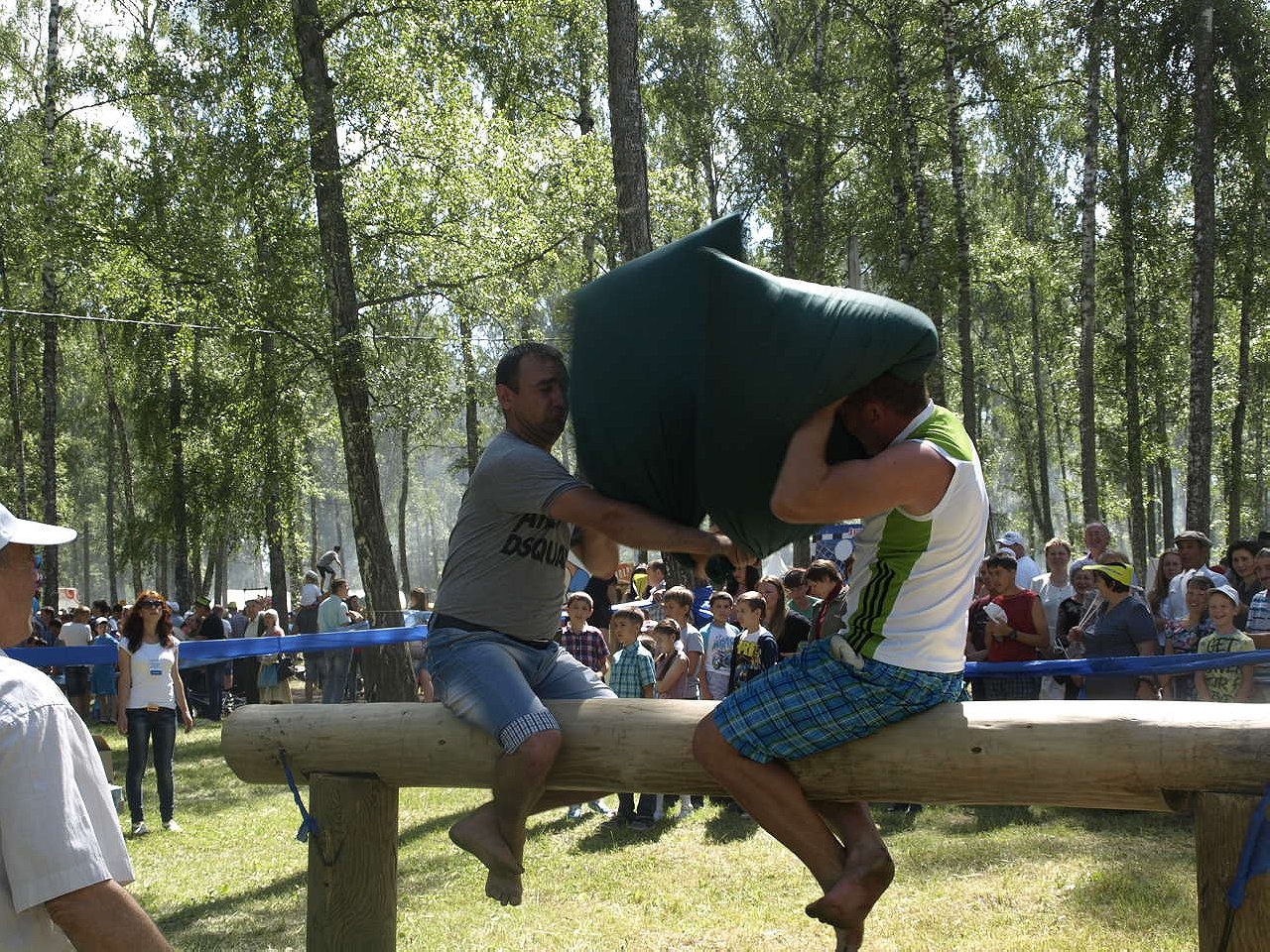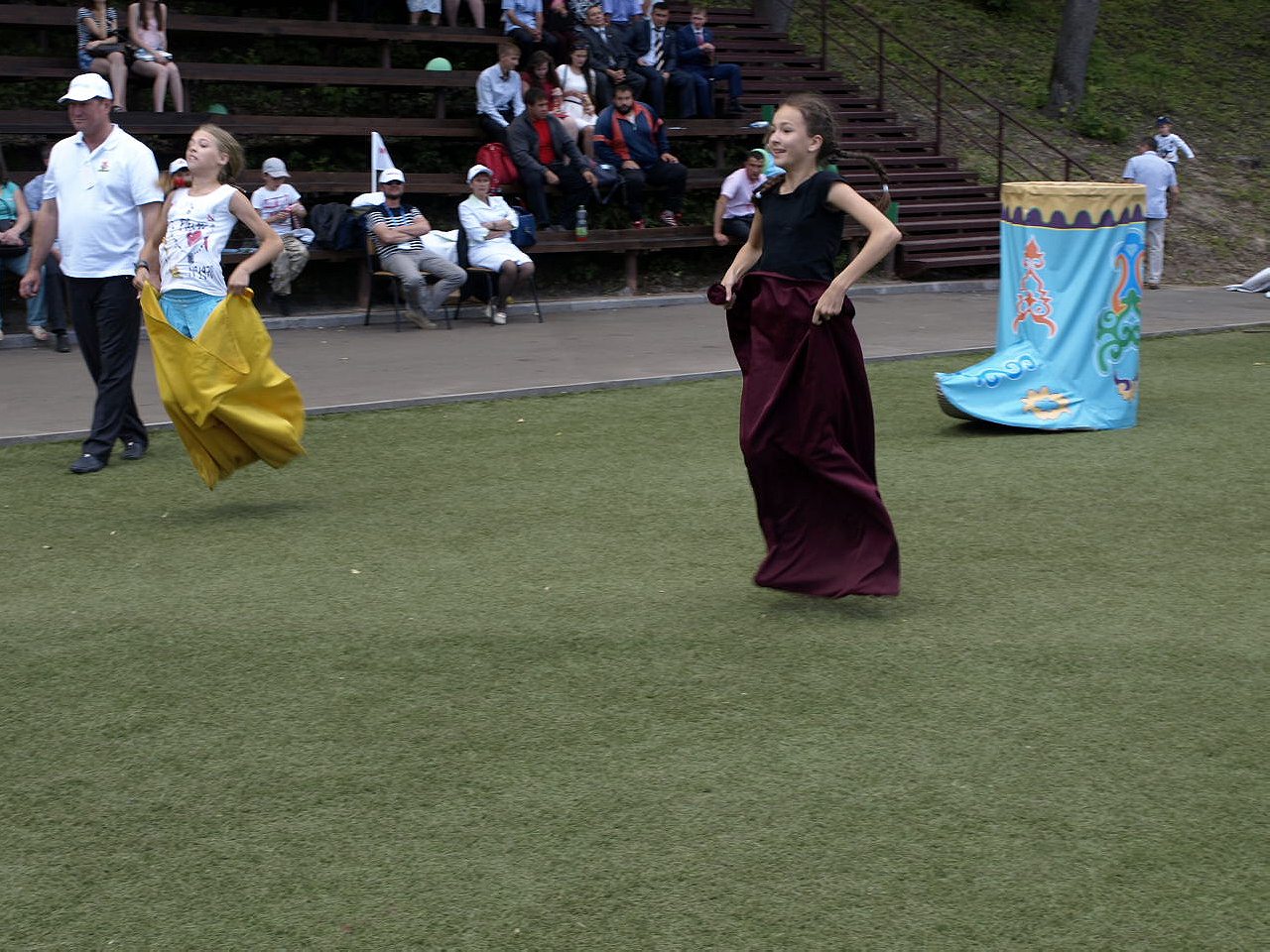This Tatar festival with pre-Islamic roots marking the summer solstice in central Russia’s Volga region has towel wrestling, pillow fights and tickle-monsters.
A blindfolded woman approaches a flower pot with a bamboo pole. She squats, she swings. Bullseye. The pot does not break, so she does not win the game. But she gets some laundry detergent as consolation.
“What prize do you get if you break the pot?” I ask.
“They don’t break,” the carnival worker answers in Tatar, then Russian. “They just come for the detergent.”
Down a row of trees are other carnival games: darts-n-balloons, can towers, firing ranges, hold onto the bar for two minutes, eat a whole chocolate bar in 60 seconds and get 1000 rubles. Through the thick crowd of people who seem to have missed the day at school where you learned to walk in a line, we finally make it to the main square.
Here we see a samovar the size of a skyscraper, tea cups big enough for Paul Bunyan, a plate of chak-chak (something like funnel cake preserved in honey) large enough to feed 500 men, and flowerpots that actually shatter when you hit them. This is the modern Sabantuy.

Harkening back to the pre-Islamic plow festivals, Sabantuy is celebrated around the summer solstice mainly in the Volga Region of Central Russia. The diaspora of Sabantuy-celebrating Turkic peoples is widespread, and one can make it to Sabantuy in tracts of open festival-ground in New York, San Francisco and Helsinki. The main representatives of these peoples are the Tatars, the largest ethnic minority in Russia. Most daily business here is conducted in Russian, but Tatar is well-preserved by families and local communities. Sabantuy is the holiday at which Tatars shine, and on the bus to the birch orchard where Sabantuy takes place near Tatarstan’s capital, Kazan, their language echoes between the walls. When I fall on an old lady at a sudden halt and apologize in Russian, she answers in Tatar “Tukta! Ekren bul!” she says. Hold on, be careful.
When I try to describe Sabantuy, certain excitements from my American childhood float to the surface: Renaissance Fair, Field Day, American Gladiators. Food carts, reproductions of medieval and ancient villages from the different regions of the Volga like a Tatar Epcot Center exhibit, and main-stage Tatar pop song-and-dance spectacles. To arrive at the Maidan, you must walk through a reproduction of an Eastern village with its vaguely oriental plow decorated with ersatz fruit, and cross a bridge over a meter-wide Volga, lined with children hooking-in plastic fish with plastic fishing rods.
As far as we know, as long as there have been Tatars, there has been Sabantuy. The ritual is described by the traveler and scholar Ahmad ibn Faldan, who traveled from Baghdad to Tatarstan’s precursor Volga Bulgar in 921 in order to teach the newly converted kingdom Islamic law. (The 2007 Syrian TV series The Roof of The World tells stories from his travels). The excavated city of silk-road powerhouse Bolgar is open to tourists today. Bolgar’s ancient ruins allow one to step into the bathhouses of kings of a people long forgotten. It is said that a portion of Bulgars migrated to what is, appropriately, now called Bulgaria.

Among his other adventures, Ahmad ibn Faldan met the Kazhars and the Varangians, the Viking predecessors of the Russians, and witnessed a ship burial, the tradition of burying the dead not in the ground but in a boat. Ibn Faldan’s writings highlight some of the culture clashes of East and West, that happen when a Muslim culture is situated within a mostly Christian country. Tatarstan has long boasted of its harmonious relationship with the rest of Russia, and though local Russians begrudgingly study the Tatar language in school and rumors of favors done for fellows members of the tribe help certain people get ahead, the region, according to professor Vladimir Zorin’s statics of ethnic criminal reports and complaints, the most tolerant in Russia. Back even to the time of Ahmad ibn Faldan, one of the reasons for this peacefulness is clear. The culture is fun. And Russians, as well as Tatars, do love some fun.

On this hot summer-starting Saturday, two dozen stages blare with traditional Tatar singing. Bobbing heads topped by Sberbank-sponsored green Tuybueteika hats file along the main road of this artificial village to an amphitheater guarded by thirty policeman and two soldiers in full fatigue. The music on stage is quite heavy on the accordion, and yet reminiscent of Chinese music. Traditional Tatar songs, like many melodies of the East, use the five-tone pentatonic scale. The performer floats around a note, encircling it with her voice, rather than hitting on the nose. Take twenty of those singers, adorn them with traditional vibrant costumes (one outfit for females features a long tube extending from the top of the head, thought to be a yonic symbol of fertility), throw it up on the megatron screen and you’ve got an idea of what the main stage is like.

Competitive events resemble something out of a sleep away camp. They include: spoon-egg races, sack races, climb-the-pole races, tug-o-war, the blindfolded flowerpot shattering, arm-wrestling championships, balance-beam pillow fights, or find coins in katyk (a yogurt-like drink made from boiled milk). Winners take home a small prize, usually a box of laundry detergent or Chinese-made badminton kit, and even sometimes an unbroken flowerpot. But the main attraction is the towel wrestling championship.
The kurash is for the serious. Competitors attempt to knock down their opponent by yanking towels tied across their waists. The actual trick is setting your opponent off balance by lifting him into the air by his towel. The wrestling victor is declared batyr, hero, and goes on to the next round. Batyrsof local kurash competitions convene in regional capitals for the championships. The grand prize for Sabantuy was traditionally a ram, which the winner would throw over his shoulder and lug home. Nowadays, the sheep prize is reserved for the more provincial competitions, and the winners in large cities drive the ram away in a brand new Lada Kalina. It’s the cheapest of Russian automobiles, but still and all: it’s a car you can win by towel wrestling.

These traditions supposedly come from pagan Turkic rites of trying to persuade the Gods to bring a fine harvest (though I cannot see the connection between arm wrestling and spiritual fertilizer). The word saban signifies spring crops or sewing, and tuy means wedding or grandeur.
One old-style house I enter seems to be of similar manufacture as a Russian hut with those bright, carved shutters. The embroidery work in the distinct cold hues on the ichigi boots has been set up for attraction and is surely Tatar. A woman sits behind a table of vareniki, blini, and kystiby (potato quesadillas) in distinctly Russian dress.
In this section of Sabantuy, there are food stands. “Can we buy this food?” a hungry visitor asks.
“It’s for show,” the food lady answers.
“Where are the meat-triangles? Where is the Shurpa noodle soup?” Another visitors questions.
“This isn’t a Tatar hut,” is the answer. “It’s a Ryazan hut.”
Some Ryazan people are of similar Turkic dissent and even preserve the language, but they were baptized when Ivan the Terrible finally captured the Khanates and surrounding kingdoms in the late middle ages.
This lack of distinction of who participates in Sabantuy is a larger question of the Volga peoples. The Chuvash, who are like the Tatars, but Christian, had not been traditionally nomadic. One result: they eat more cabbage. The Bashkirs have an extremely similar language, and there are more Tatars living in Bashkiria. Of all the Tatar traditions that have seeped into Chuvash and Bashkir and the larger culture, though, Sabantuy is perhaps the greatest success. All these Volga peoples celebrate Sabantuy, and there is no exclusion. Anyone is permitted to join the party: for example, though Tatars are traditionally Muslim, I enjoyed some excellent pork shashlik at their Sabantuy.
It is the festival of the diaspora. Way back when, Stalin wanted to deport the Volga Tatars off to Siberia but was advised against it. There were too many of them, they were too organized, had too big a sense of community to send off without a problem. Turkic peoples make up between 6-10% of the population of Russia, and those with a Tatar babushka here or there are even more numerous. What is more, the Kazan Tatars have cousins in Siberia, Crimea, Uzbekistan and now Germany and the United States. If there are 8 or 10 million Tatars, that might not seem like a nation without borders, but compared to some microstates of Europe that’s a significant population. Plenty of famous Russian have Tatar roots, including the ranks of the great Yusupov clan, the family whose wealth outstripped even the Royal Romanovs.

The biggest minority harbors two advantages to keep itself together: a living language and oil. Not all ethnic nations in Russia have fared as well as the Tatars. The people of Yakutia have seen diamonds mined away to provide wealth for the European portion of the country, and the nomadic Chukchi, ever the brunt of jokes, are seeing their indigenous culture and livelihood sold out from under them. Tafneft, the Tatarstan-based oil conglomerate, plays nice with Moscow, but it is the sixth-largest oil company in Russia and its power is still concentrated within Tatarstan. There is as much as a billion tons or more of extractable fossil fuel under Tatarstan’s soil. Money cycles back to Kazan in the forms of municipal projects such as the 2005 Thousand-Year-Anniversary remodeling of the city, the 2013 Summer Universiade Games and Next Year’s World Swimming Championships.
Yet threats remain. This year has seen a sharp uptick in Kremlin meddling in Russian culture. A law was proposed in the Duma that would make “adulteration or refusal of patriotism” a finable offense.
Recent laws prohibit certain vulgar words from use in public discourse, theater, and even literature, and there is a bill to open an academy of the Russian language similar to the Académie Française to regulate and purify Russian. Would such an academy aspire to purify and regulate the Tatar language as well? Or any of the other dozens of minority languages in Russia? This is what makes the five-tone music ringing out from massive speakers so important. In a country where nationalism is on the rise, things like Sabantuy, and a strong Tatarstan culture, are all the more crucial.

Returning to the city on the bus, the motor shakes hard enough to make my jaw vibrate. There seem to be no brake pads, so every stop or slowdown makes the whole salon of people fall into each other. The bus speeds up over a hill and all the passengers float in the air for what feels like six seconds. “There are children and pregnant women on this bus! Slow down!” screeches someone in the back. But the full cabin means we act as packaging peanuts, keeping everyone standing protected, though occasionally squishing against another very soft grandmother who yelps out something nasty in Tatar again. The driver twists together exposed wires to turn on the fan, which seems to have come from a tower computer, and the conductor curses someone for not paying, and somehow neither driver nor conductor spills their teas. But just then a breeze comes in from the windows, and somebody finds an accordion. The Russians make up the words they don’t know, the Tatars are familiar with them from childhood, and before we get to the metro station everyone is singing.
